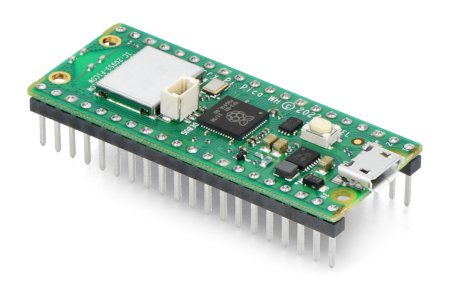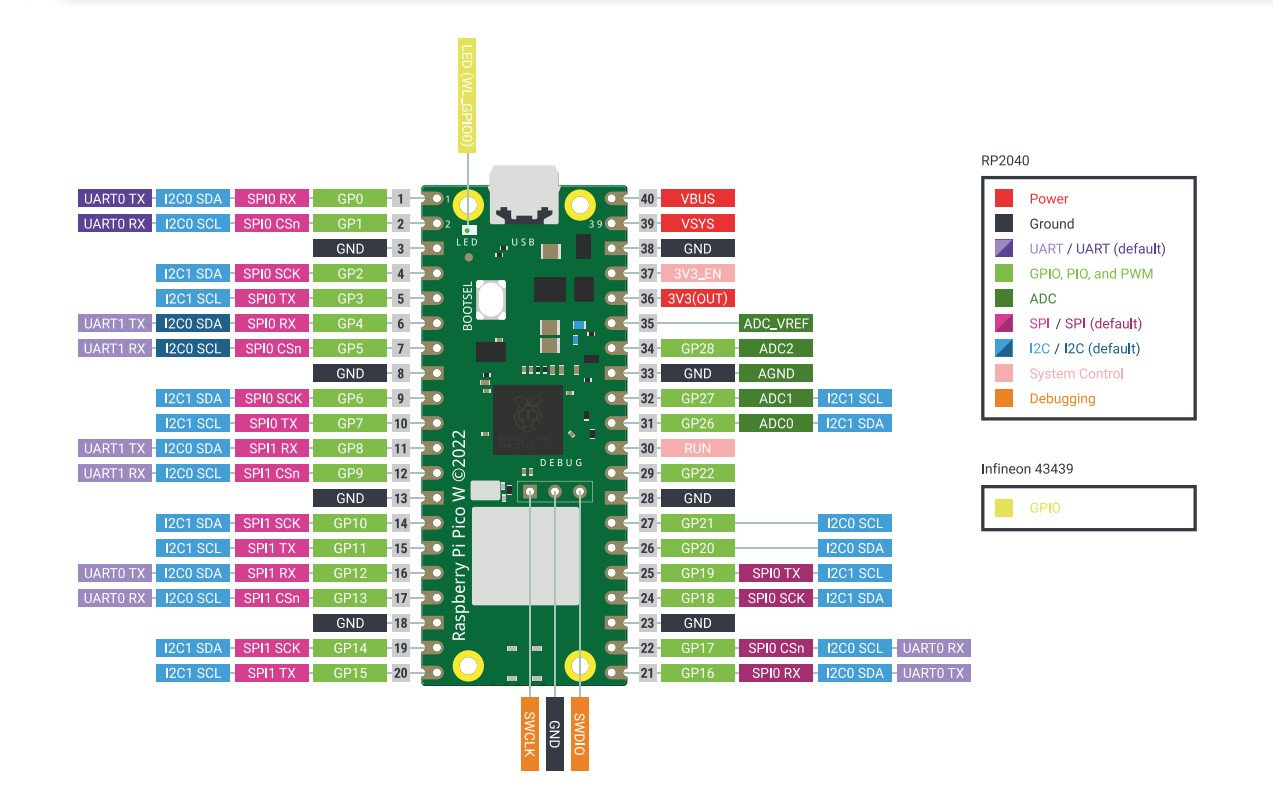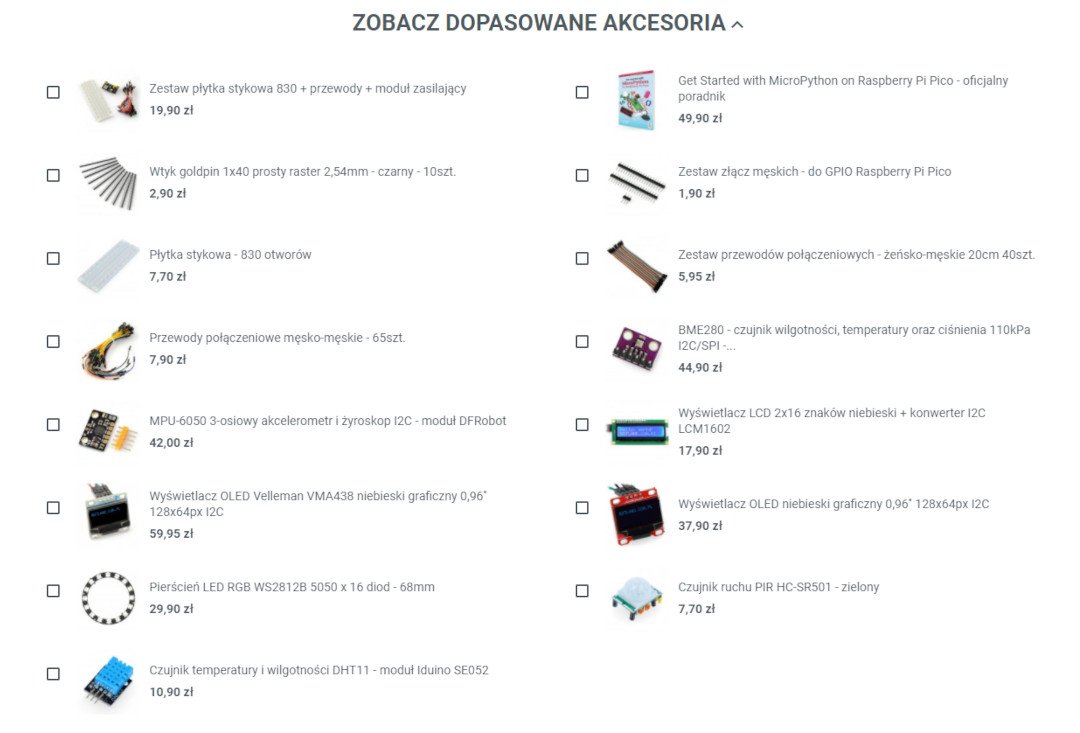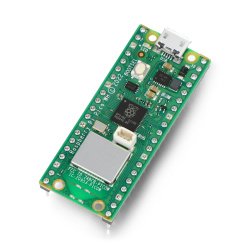Product description: Raspberry Pi Pico WH - RP2040 ARM Cortex M0 + CYW43439 - WiFi - with connectors
The Raspberry Pi Pico WH is based on the proprietary Raspberry RP2040 microcontroller and the Infineon CYW43439 wireless communication system. RP2040 is a dual-core ARM Cortex M0 + chip clocked at 133 MHz with 264 KB of SRAM and 2 MB of Flash memory. The built-in CYW43439 chip allows for wireless IEEE 802.11 b / g / n WiFi communication. Pico WH has 26 GPIO pins that work with a voltage of 3.3 V. The board also has a built-in temperature sensor. Raspberry Pi Pico WH is programmed via the microUSB port in C / C ++ and MicroPython.
Pins of the Raspberry Pi Pico WH module
The Raspberry Pi Pico WH board has 26 GPIO pins, including the following interfaces: 2x SPI, 2x I2C, 2x UART, 3x ADC 12-bit, 16x PWM. The module is additionally equipped with 8 programmable IO pins (PIO), which are designed to support non-standard peripheral devices.
Power supply for the Raspberry Pi Pico WH
The Pico WH module is powered via the built-in microUSB port, which is also used for communication between the Raspbery Pi board and the computer. For proper operation, the module requires a 5V power supply. The board can also be powered from the VSYS pin with voltage from 1.8 V to 5.5 V , using, for example, a 3.7 V Li-Pol battery or a 3x AA battery.
|
The logical part of the Raspberry Pi Pico works with a voltage of 3.3 V. |
Programming Raspberry Pi Pico WH
The Raspberry Pi Pico WH can be programmed with both C / C ++ and MicroPython . The process of uploading the program to the board is extremely simple, to do this, press and hold the BOOTSEL button, and then connect the Raspberry Pi Pico WH to the computer with a microUSB cable. The computer will detect the module as a USB mass storage device named RPI-RP2. The prepared program file should be dragged and dropped into the newly found volume. The manufacturer provides an SDK repository for the C / C ++ and MicroPython programming languages, which can be found in the useful links below.
Getting started with MicroPython
The Raspberry Pi Pico WH is programmed by "throwing" the prepared MicroPython program into the USB mass storage volume created by the board on the computer. There is also a sample UF2 file for download to help you get started with MicroPython.
- Download the MicroPython UF2.
- Press and hold the BOOTSEL button and plug the board into the USB port of your Raspberry Pi or computer.
- Release BOOTSEL when Pico is connected to your computer.
- The Raspberry Pi Pico will be detected as a mass storage device with volume RPI-RP2.
- Drag and drop the MicroPython UF2 file to the RPI-RP2 volume.
- Pico will restart, MicroPython will now be used.
- You can access REPL and MicroPython via the serial USB port.
Hello World in C / C ++
The first program any programmer will write is "Hello World", in this case the Raspberry Pi Pico WH will be programmed via the Raspberry Pi 4B 's USB serial port.
- Download the UF2 file "Hello World".
- Press and hold the BOOTSEL button and connect the Raspberry Pi Pico to the Raspberry Pi's USB port.
- The board is detected as a mass storage device with volume RPI-RP2.
- Drag and drop the UF2 file to the RPI-RP2 volume.
- Pico will restart.
- Open a terminal on the Raspberry Pi 4B and run the commands:
sudo apt install minicom minicom -b 115200 -o -D / dev / ttyACM0
- You should see "Hello World" listed in the terminal window.
Additional accessories for the Raspberry Pi Pico W
Check out the additional accessories we have prepared for the Raspberry Pi Pico W module. Accessories can be found in the See matching accessories section, under the photo gallery. By choosing these accessories, you can follow the manufacturer's examples from the SDK documentation for C and Python.
Specification of the Raspberry Pi Pico WH
| Parameter | Value |
|---|---|
| System | Raspberry Pi RP2040 |
| Core | ARM Cortex-M0 + Dual-Core 133 MHz |
| Wireless communication system | CYW43439 |
| Wireless communication | WiFi 2.4 GHz IEEE 802.11 b / g / n |
| SRAM memory | 264 kB |
| Flash memory | 2 MB |
| Leads | 40-pin / 23 GPIO digital + 3 ADC pins |
| Interfaces | 2x UART, 2x I2C, 2x SPI, up to 16 PWM channels |
| Supply voltage | 5 V (USB) |
| Working voltage of the logical part | 3.3 V |
| Power / data connector | microUSB |
| Dimensions | 51.3 x 21 x 12.9 mm |
Useful links |


































































































































































































































































































































































